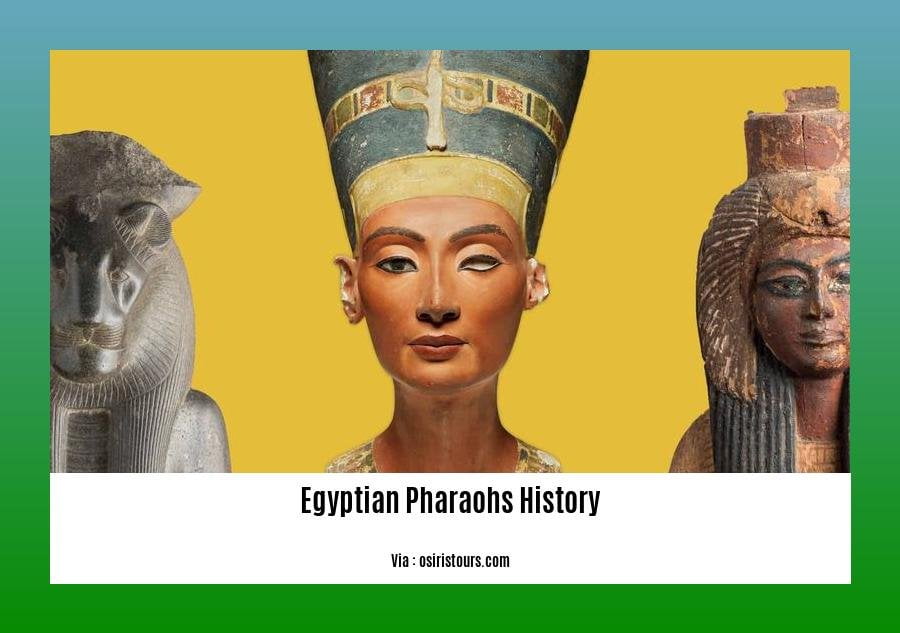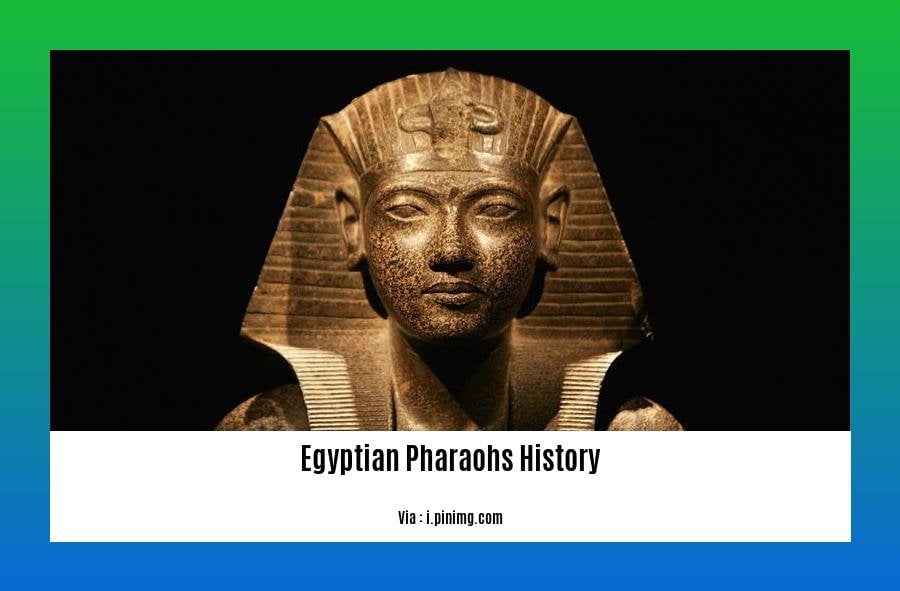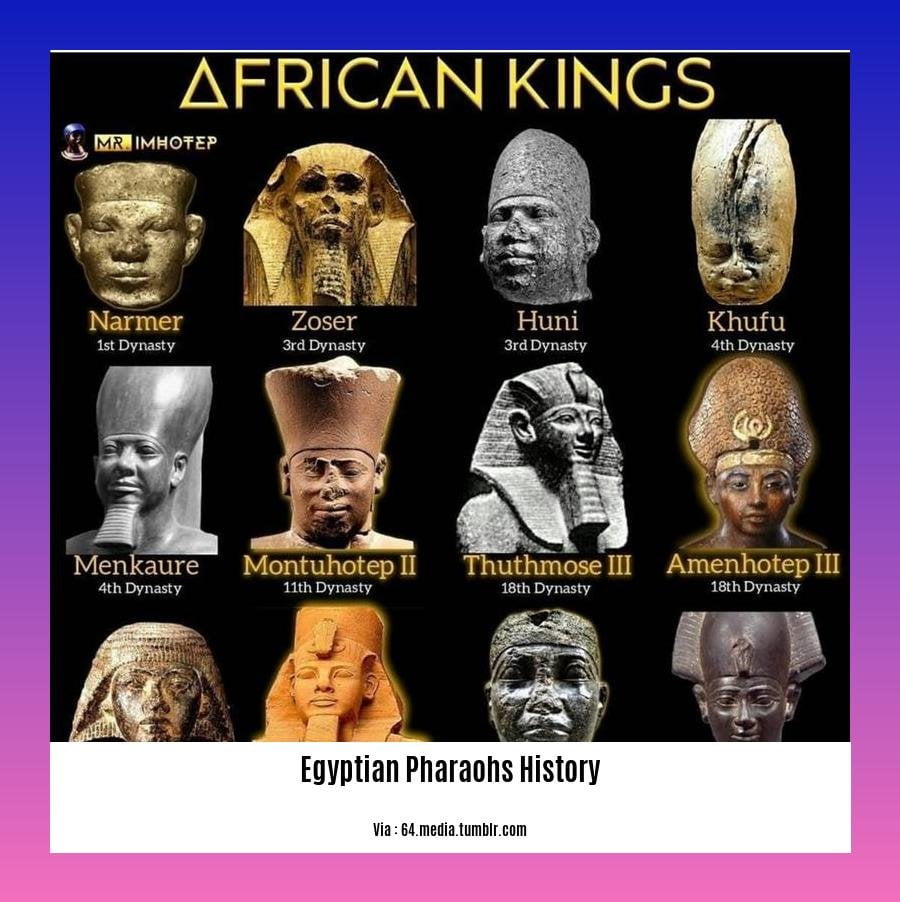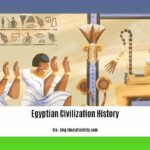Step into the captivating world of ancient Egypt and unravel the enigmatic history of its pharaohs in “Unveiling the History of Egyptian Pharaohs: A Comprehensive Exploration.” This article delves into the lives, reigns, and legacies of these iconic rulers, providing a fresh perspective on their impact on the civilization that shaped the course of human history.
Key Takeaways:
- Pharaohs ruled ancient Egypt for over 3,000 years.
- They were considered god-kings, representing the link between the people and the gods.
- Pharaohs wore unique crowns symbolizing the unification of Egypt.
- Ancient Egypt faced conquests from various powers, including Rome.
- Cleopatra was the last ancient Egyptian pharaoh, committing suicide after the Roman takeover.
Egyptian Pharaohs History

Have you ever wondered about the egyptian pharaohs history? Their power, their wealth, and their enigmatic allure?
Let’s dive right into the captivating world of the pharaohs, the divine rulers of ancient Egypt.
The Divine Nature of Pharaohs
Pharaohs were not merely mortal rulers; they were considered living gods, the embodiment of Horus and Ra. They held the keys to cosmic order, ensuring the harmony of the universe.
Monumental Legacies
The pharaohs left an indelible mark on Egypt’s landscape, constructing monumental structures that defy time. The towering Pyramids of Giza, the sprawling Karnak Temple, and the opulent Valley of the Kings are testaments to their architectural prowess.
Notable Pharaohs and Dynasties
Throughout Egypt’s long history, many pharaohs rose to prominence, each leaving their unique imprint.
- Khufu: Builder of the Great Pyramid of Giza, one of the Seven Wonders of the Ancient World
- Hatshepsut: The first female pharaoh, who ruled Egypt for over 20 years
- Tutankhamun: The enigmatic boy-king whose intact tomb provided a glimpse into the splendor of the New Kingdom
- Cleopatra: The last pharaoh of ancient Egypt, known for her beauty, intelligence, and tragic romance with Marc Antony
Daily Life and Culture
Pharaohs led opulent lives, surrounded by lavish palaces, royal courts, and an army of servants. Their daily rituals and administrative responsibilities shaped the lives of all Egyptians.
Uncover the egyptian pharaohs history, a captivating tapestry of divine power, monumental achievements, and enduring legacies. Their influence extends far beyond the sands of time, continuing to inspire and fascinate generations to come.
Discover the rich history of the history of ancient egypt, uncovering the grandeur of a civilization that shaped our world. Delve into the timeline of ancient egypt timeline, witnessing the rise and fall of pharaohs and tracing the evolution of a remarkable society. Explore the intriguing egyptian civilization history, unraveling the secrets and innovations that made it one of the most influential civilizations in human history.
Monumental Legacies
Unveiling the Legacy of Ancient Egypt’s Pharaohs
Step into the enigmatic world of the Egyptian pharaohs, rulers who left an indelible mark on history through their colossal constructions and lasting legacies.
Monumental Legacies
The pharaohs’ unwavering belief in their divine nature and the need for eternal life inspired the creation of awe-inspiring structures that defied human imagination.
- Pyramids: Colossal tombs like the Great Pyramid of Giza symbolized the pharaoh’s power and served as an eternal resting place.
- Temples: Majestic edifices dedicated to the gods, such as Karnak Temple, showcased the pharaoh’s role as mediator between the divine and earthly realms.
- Tombs: Elaborate underground chambers, like the Valley of the Kings, were filled with treasures and artifacts, ensuring the pharaoh’s comfort in the afterlife.
Key Takeaways:
- Pharaohs wielded both temporal and spiritual power, ruling over vast empires and embodying the will of the gods.
- Their monumental constructions, including pyramids, temples, and tombs, showcased their divine nature and enduring legacies.
- The pharaohs’ belief in the afterlife influenced their architectural achievements, ensuring their eternal comfort and divine protection.
Most Relevant URL Source:
- “10 Most Famous Pharaohs of Egypt” by World History Edu:
Rulers and Dynasties

When we traverse through the annals of ancient Egypt, the rulers and dynasties stand as towering figures, shaping the destiny of this captivating civilization. From the unification of Upper and Lower Egypt under Narmer to the reign of Cleopatra, the last pharaoh of Egypt, these enigmatic individuals left an enduring legacy.
The pharaohs were not mere mortals but living gods, embodiments of Horus and Ra, responsible for maintaining cosmic order. They commissioned colossal monuments like the pyramids of Giza, the Karnak Temple, and the Valley of the Kings, showcasing their architectural prowess.
Throughout Egypt’s rich history, notable rulers and dynasties emerged, each with their unique contributions. Khufu, the builder of the Great Pyramid, Hatshepsut, the first female pharaoh, and Tutankhamun, the enigmatic boy-king, are just a few examples that continue to fascinate us today.
Key Takeaways:
- The pharaohs were considered living gods, embodying Horus and Ra.
- They were responsible for maintaining cosmic order and constructing monumental structures like pyramids and temples.
- Notable rulers and dynasties include Narmer, Djoser, Khufu, Hatshepsut, Thutmose III, and Cleopatra.
Most Relevant URL Source:
- “10 Most Famous Pharaohs of Egypt” by World History Edu:
Daily Life and Culture
Their Lavish Palaces and Regalia:
The lives of pharaohs were ones of luxury and privilege. They resided in grand palaces adorned with opulent furnishings, vibrant paintings, and intricate hieroglyphs. Their clothing was equally extravagant, with finely woven linen garments, elaborate jewelry, and ceremonial headdresses that symbolized their divine power.
Divine Obligations and Rituals:
As living gods, pharaohs held religious and ceremonial responsibilities. They performed daily rituals to maintain the cosmic order, such as making offerings to deities and participating in temple ceremonies. These rituals were not only symbolic but also crucial for ensuring the well-being of the kingdom.
Family, Harems, and Succession:
Pharaohs often had multiple wives and concubines, forming extensive harems. However, only one wife held the title of Great Royal Wife, serving as the primary consort and potential successor. The succession to the throne was not always straightforward, and the chosen heir often faced challenges and rivalries within the royal family.
Education and Training:
From a young age, pharaohs received rigorous training and education. They studied hieroglyphics, mathematics, history, and military strategy. Their education prepared them for the complex administrative and political challenges they would face as rulers of ancient Egypt.
Legacy of Grandeur:
Throughout their lives, pharaohs commissioned monumental projects that reflected their power and divine status. From towering pyramids to colossal temples, these architectural wonders showcased their architectural prowess and ensured their legacies would endure for centuries to come.
Key Takeaways:
- Pharaohs lived in opulent palaces and wore elaborate regalia.
- They performed daily rituals to maintain cosmic order.
- Pharaohs often had multiple wives and concubines.
- Succession to the throne was not always straightforward.
- Pharaohs received extensive education and training.
- They commissioned monumental projects that showcased their power.
Most Relevant URL Source:
FAQ
Q1: When did the era of pharaohs begin in ancient Egypt?
A1: The era of pharaohs in ancient Egypt began around 3100 BC when Narmer, the first pharaoh, unified Upper and Lower Egypt.
Q2: Which pharaoh is famous for constructing the Great Pyramid of Giza?
A2: Khufu, the second pharaoh of the Fourth Dynasty, is renowned for commissioning the construction of the Great Pyramid of Giza, one of the most iconic structures in the world.
Q3: What was the significance of the pharaoh’s double crown?
A3: The double crown, known as the pschent, symbolized the unification of Upper and Lower Egypt and was worn by pharaohs during important ceremonies and festivals.
Q4: Which female pharaoh is known for her ambitious reign and military achievements?
A4: Hatshepsut, the fifth pharaoh of the Eighteenth Dynasty, is celebrated as one of the most successful female pharaohs, known for her architectural projects and her military campaigns that expanded Egypt’s empire.
Q5: When did the rule of native Egyptian pharaohs end?
A5: The rule of native Egyptian pharaohs came to an end in 343 BC when Nectanebo II was defeated by the Achaemenid Empire. Egypt was later conquered by Alexander the Great in 332 BC, and the Ptolemaic dynasty, led by Greek pharaohs, ruled Egypt for almost 300 years.
- Sept 31 Myth: Unveiling Calendar Secrets - March 18, 2025
- How Long & Till December 18, 2025: Accurate Countdown Guide - March 18, 2025
- Discover Japanese Artists: A Complete History - March 18, 2025
















